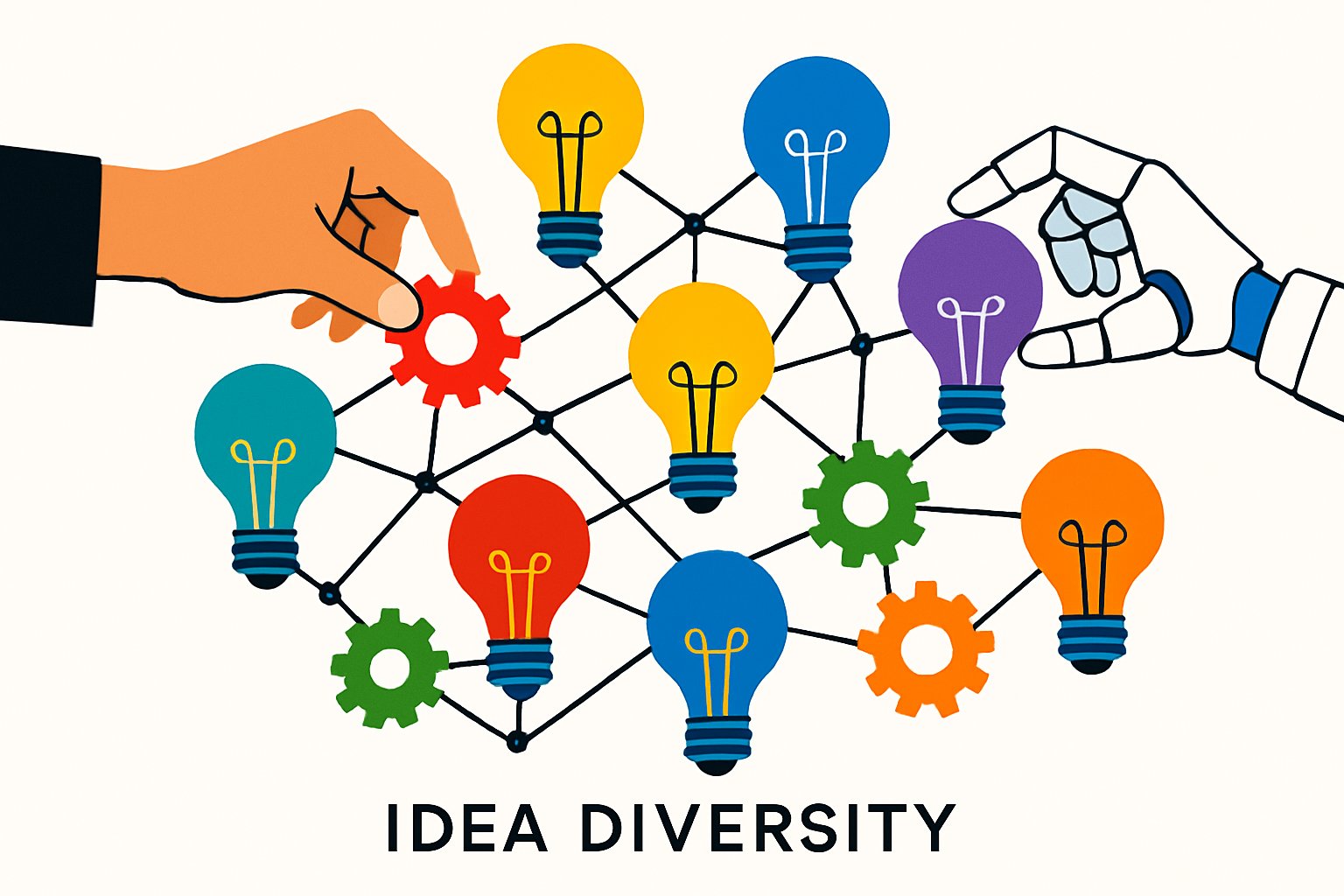
AI CERTS
13 hours ago
Human-AI Co-Creativity Model: Idea Quality & Diversity
This article unpacks evidence, risks, and mitigation tactics for leaders designing augmented brainstorming pipelines. Along the way, we reference certified skill paths such as the AI+ Business Intelligence™ credential. Readers will gain actionable guidance for embedding responsible AI creativity frameworks within everyday product cycles. Meanwhile, experts share pragmatic prompts that keep idea variance alive.
AI Creativity Trade Offs
Empirical work across 2024-2025 reveals a clear performance pattern. LLMs elevate originality scores for single ideas across product naming, process tweaks, and marketing angles. In contrast, teams relying heavily on ChatGPT often output near-identical concepts, reducing mean idea variance by 30%. Furthermore, Wharton experiments documented clustering even when participants used separate chats.

- OpenAI reports 400M weekly ChatGPT users as of Feb 2025.
- Nature study shows 28% lower idea diversity with naive prompts.
- Market forecasts expect 40% CAGR for generative-AI software through 2029.
Consequently, leaders must weigh creativity gains against homogenization risks. These trade-offs define why the Human-AI Co-Creativity Model demands structured human input. However, structured interventions only succeed when integrated early within brainstorming pipelines. AI boosts average idea quality yet shrinks diversity. However, human anchoring can restore balance, as the next section explains.
Anchoring Role Of Humans
Anchoring involves purposeful seeding, critique, and selection by human facilitators. Moreover, it positions the human as curator rather than passive referee. Wharton researchers recommend parallel human ideation streams before any machine interaction. They also urge iterative evaluation using explicit diversity metrics like cosine distance.
This augmented brainstorming loop maintains momentum while protecting originality. Practical anchoring tactics align with the Human-AI Co-Creativity Model philosophy. For example, moderators can request ten radically different product ideas, then rank them using domain criteria. Meanwhile, chain-of-thought prompts guide the model through multiple reasoning paths, widening output spread. Additionally, rotating personas or role-play scenarios inject novel frames into conversations.
Intentional human anchoring counters convergence effects. Next, we explore engineered prompts that magnify this benefit.
Engineering Diverse Prompt Strategies
Prompt engineering translates theory into repeatable tactics. Researchers tested dozens of templates across tasks during 2024 and 2025. They found chain-of-thought, deliberate contradiction, and multi-persona prompts improved idea variance by up to 40%. Furthermore, simple instructions like "generate answers nothing alike" drove additional spread.
- Chain-of-thought reasoning steps.
- Ask for mutually exclusive solutions.
- Restart chat for each idea.
- Use opposing expert personas.
Consequently, disciplined prompting supports the Human-AI Co-Creativity Model by algorithmically scaffolding diversity. Nevertheless, systematic human review remains essential. Teams piloting the Human-AI Co-Creativity Model reported faster concept cycles without sacrificing originality. These strategies align with emerging creativity frameworks taught in executive programs. Engineered prompts expand idea space quickly. However, market context determines whether those ideas hold value, our next focus.
Market Stakes And Adoption
The commercial incentive for better ideation keeps rising. S&P Global projects $85 billion in generative-AI revenue by 2029, reflecting 40% CAGR. Meanwhile, venture funding pours into productivity suites promising augmented brainstorming at enterprise scale. OpenAI already counts 400 million weekly users, underscoring adoption velocity.
However, enterprises report mixed returns when teams skip structured creativity frameworks. Projects stall due to governance gaps, hallucination risks, or bland output that fails to excite customers. Therefore, executives need measurable approaches like the Human-AI Co-Creativity Model to justify continued investment. Professionals can enhance strategic insight with the AI+ Business Intelligence™ certification. Investor memos now reference the Human-AI Co-Creativity Model as a diligence checkpoint.
Adoption grows, yet returns hinge on disciplined methods. Next, we outline a workflow playbook to operationalize such discipline.
Practical Workflow Playbook Tips
The following playbook converts research into daily practice. First, schedule separate human sprints before any machine interaction. Subsequently, run an augmented brainstorming round using diverse prompts and independent chats. Then, aggregate outputs into a matrix that scores creativity, feasibility, and alignment with strategy.
After scoring, convene a review panel to select top ideas and refine prompts for a second pass. Additionally, route shortlisted ideas through domain experts for risk evaluation. Use creativity frameworks like E.A.R.T.H. or Double Diamond to structure this vetting. Finally, document prompt settings, diversity scores, and human decisions for audit purposes. Each stage maps clearly onto the Human-AI Co-Creativity Model architecture shared by Wharton scholars.
A documented workflow turns theory into predictable output. However, governance and skills development remain pivotal, as discussed next.
Governance And Future Research
Regulators and scholars emphasize the continuum of human-in-the-loop designs. UNESCO urges pedagogy-first models where educators guide AI instead of deferring to automation. Moreover, legal scholars debate liability when the Human-AI Co-Creativity Model scales across regulated sectors. Clear documentation of human decisions mitigates accountability risks.
Future research will track long-term creativity skills when workers rely on augmented brainstorming daily. Large longitudinal studies remain scarce, presenting an opportunity for industry-academic partnerships. Meanwhile, vendors race to embed real-time diversity metrics within tooling, closing feedback loops automatically. Consequently, professionals who master robust creativity frameworks will shape these platforms' evolution.
Governance debates will intensify as adoption widens. Still, skilled humans can steer AI toward responsible creativity gains.
Conclusion And Next Steps
Research proves AI can uplift idea quality yet dampen diversity. However, the Human-AI Co-Creativity Model demonstrates how structured human input reverses that loss. Consequently, leaders should pair engineered prompts with parallel human critique. Moreover, market data confirms disciplined teams capture faster innovation cycles and stronger competitive moats. Meanwhile, governance frameworks secure accountability across regulated domains. Professionals can deepen expertise through the AI+ Business Intelligence™ program and related courses. Therefore, act now: pilot the methods, measure diversity, and iterate relentlessly. Future breakthroughs will favor organizations that master responsible, scalable co-creation today.



